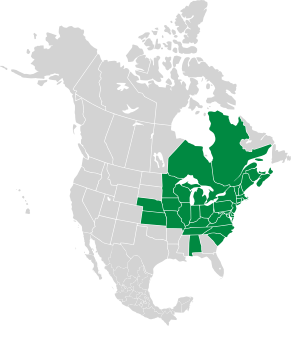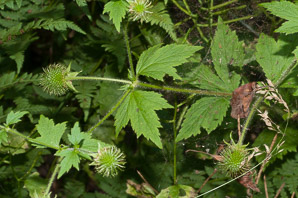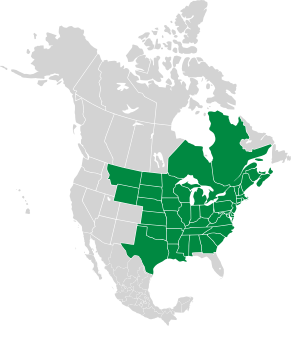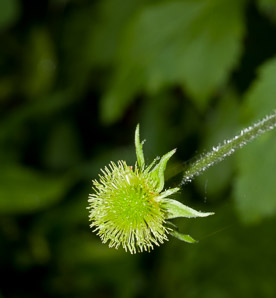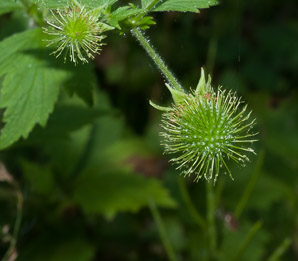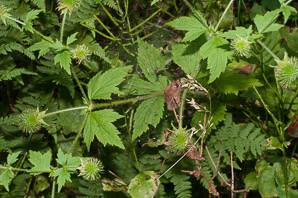
|
Geum laciniatum Murray Rough avens
Rough avens is a North American native plant. It prefers partial sun and sandy or loamy moist soil, in thickets, meadows, and roadsides. Plants: 1½-2½′ (45-76 cm) tall. Stems are light green and hairy, with hairs spreading outward. Leaves: Lower leaves are in groups of 3-5, while upper leaves have 1-3. Leaflets are simple (not further lobed), lanceolate or ovate, up to 3″ (7.6 cm) × 2½″ (6.3 cm). The odd leaflet in the center of the group is the largest. Leaf shape is highly variable. At the base where leaflets connect to the main stem are leafy stipules, like miniature leaflets. Flowers: White or cream-colored, oval to egg-shaped, about ½″ (1.3 cm) around, in groups of 1-3, on leafy racemes. There are five rounded petals, and between them, five sharp-tipped sepals that together resemble a star. The sepals are longer than the petals. A large cluster of green carpels, looking a little like a writhing mass of tiny green inchworms, make up the center of the flower, with some yellowish anthers. Flowers appear from April to May. Fruits: Flowers are replaced with green velcro-like balls of achenes about ¾″ (1.9 cm) in diameter. These are closely similar: |
6/4/2010 · Nashua River Rail Trail, Ayer, Massachusetts · ≈ 7 × 11″ (18 × 27 cm) 7/15/2012 · Fort Point State Park, Stockton Springs, Maine · ≈ 9 × 6″ (22 × 14 cm) |
||||||||||||||||||||||||||||
|
| |||||||||||||||||||||||||||||
Geum canadense |
|||||||||||||||||||||||||||||
|---|---|---|---|---|---|---|---|---|---|---|---|---|---|---|---|---|---|---|---|---|---|---|---|---|---|---|---|---|---|
| Common Name |  |
||||||||||||||||||||||||||||
| Plant | 1½-2½′ (45-76 cm) tall. Lower stems have coarse hairs and a brownish color, becoming softer-haired and lighter in color toward the top. | ||||||||||||||||||||||||||||
| Flowers | White, with five rather sparse-looking, rounded petals appearing between a five-pointed green star of sepals. The sepals are shorter than the petals. | ||||||||||||||||||||||||||||
| Leaves | Lobed, looking a bit like a rounded maple leaf, or sometimes split into three separate leaflets like strawberry leaves. The basal leaves are trifoliate. They have long stems (petioles), and they are toothed, with sharp or rounded teeth. | ||||||||||||||||||||||||||||
| Fruit | Burlike in appearance, like a little ball of velcro, though if you take a close look, the tips of the achenes, though bent, are not hooked to hitch a ride the way burs are. The fruits are the most easily noticed features of this plant, perched atop long stems. | ||||||||||||||||||||||||||||
| Range/ Zones |
|
||||||||||||||||||||||||||||
| Habitats | Moist woods and thickets | ||||||||||||||||||||||||||||
| Type | Wild | ||||||||||||||||||||||||||||
| Occurrence | Common | ||||||||||||||||||||||||||||
Online References:
References:
Clemants, Steven; Gracie, Carol, Wildflowers in the Field and Forest, Oxford University Press, 2006, p. 302
6/4/2010 · Nashua River Rail Trail, Ayer, Massachusetts · ≈ 3 × 4½″ (7.9 × 11 cm) 
7/15/2012 · Fort Point State Park, Stockton Springs, Maine · ≈ 5 × 3½″ (13 × 9.2 cm) ![]() ID is uncertain
ID is uncertain 
Geum laciniatum description by Thomas H. Kent, last updated 25 May 2020.
© FloraFinder.org. All rights reserved.
7/15/2012 · Fort Point State Park, Stockton Springs, Maine · ≈ 12 × 8″ (31 × 20 cm) ![]() ID is uncertain
ID is uncertain 
7/15/2012 · Fort Point State Park, Stockton Springs, Maine · ≈ 7 × 4½″ (17 × 11 cm) ![]() ID is uncertain
ID is uncertain 
Range:
